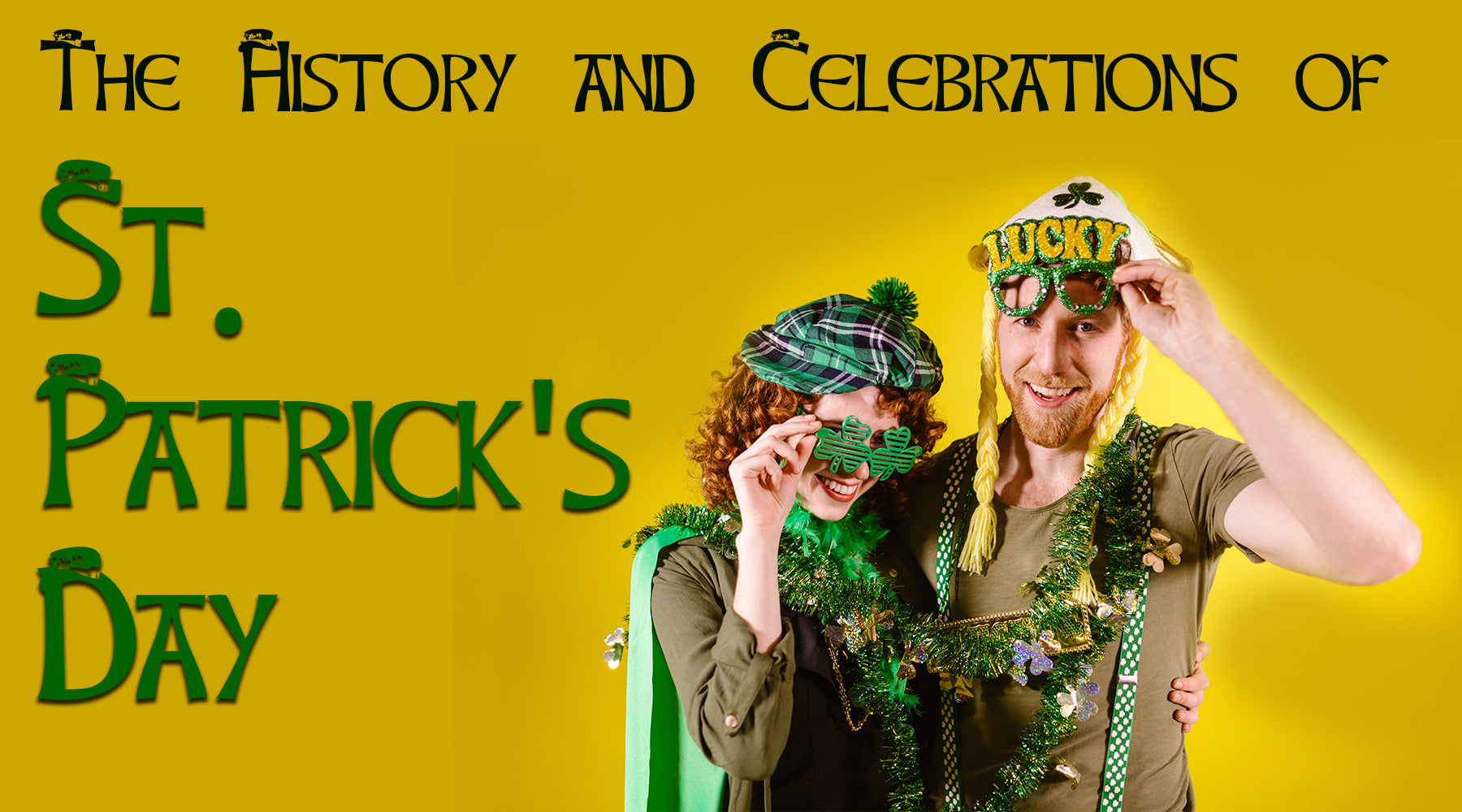The History and Celebrations of St. Patrick’s Day

Discover the fascinating history and traditions of St. Patrick's Day in this informative blog. From its origins to modern-day celebrations, learn all about the iconic holiday that has captured the hearts of millions around the world.
Saint Patrick's Day is just around the corner, and we can feel the excitement in the air! St. Patrick's Day is a beloved holiday celebrated in many parts of the world. This day is named after St. Patrick, the patron saint of Ireland, and is a celebration of Irish culture and heritage. While it has been celebrated in Ireland for over a thousand years, St. Patrick's Day is now widely observed around the world, including in the United States.
In the USA, St. Patrick's Day is a festive occasion that is marked by parades, green decorations, and Irish-themed events. Major cities like New York, Boston, and Chicago hold large parades that are attended by thousands of people each year. Many bars and restaurants offer Irish food and drink specials, while people of all backgrounds don green clothing and accessories in honor of the day.
Despite its popularity, the History and Celebrations of St. Patrick's Day in the United States are rooted in the struggles of Irish immigrants, who faced discrimination and hardship when they first arrived in the country. In this blog, we will explore the fascinating history of St. Patrick's Day and how it has come to be one of the most beloved holidays in the United States and beyond.
St. Patrick and the Origins of St. Patrick's Day

St. Patrick is a widely celebrated figure in Irish culture and the patron saint of Ireland. Born in Britain in the late fourth century, he is known for his missionary work in Ireland and for bringing Christianity to the country. St. Patrick is remembered for his efforts in establishing monasteries, churches, and schools in Ireland, and for his use of the shamrock as a symbol to teach the Irish about the Holy Trinity. His legacy is celebrated on St. Patrick's Day, which is observed around the world as a day to honor Irish culture and heritage. St. Patrick died on March 17th, which became his feast day in the Catholic Church. This day was initially celebrated in Ireland as a religious holiday, but it soon became a secular holiday as well.
First St. Patrick’s Day Celebration
St. Patrick's Day has a long and rich history that dates back to ancient times. While the exact date of the first St. Patrick's Day celebration is not known, it is believed to have been celebrated by the Irish people as a religious holiday long before it was officially recognized. St. Patrick's Day has been celebrated in Ireland since the 9th or 10th century. However, the first recorded St. Patrick's Day parade was held in a Spanish colony, now St. Augustine, Florida, in 1601. The parade was organized by the Irish vicar Ricardo Artur. Homesick Irish soldiers in the English military later marched into New York City on March 17, 1772, to honor the Irish patron saint. The popularity of the St. Patrick's Day parade in New York City, Boston, and other American cities only grew from there, eventually becoming a beloved holiday celebrated worldwide.
The Rising Popularity of St. Patrick's Day
As Irish immigrants settled in America, their patriotism and desire to celebrate their culture led to the formation of Irish Aid societies. These societies organized annual parades featuring bagpipes and drums, which became a popular tradition. In 1848, multiple New York Irish Aid societies joined forces to create the official New York City St. Patrick’s Day Parade. This parade has since become the world’s oldest civilian parade and the largest in the United States, drawing in over 150,000 participants and nearly 3 million spectators each year. Other American cities, such as Boston, Chicago, Philadelphia, and Savannah, also celebrate St. Patrick's Day with their own parades. The COVID-19 pandemic canceled many 2020 and 2021 parades, but most returned in 2022.

St. Patrick's Day and its impact on American politics
In the 19th century, Irish immigrants in America faced discrimination due to their religious beliefs and accents. They were often portrayed in a negative light in newspapers and other media. However, their growing numbers gave them political power that they could use to their advantage. St. Patrick's Day celebrations became an opportunity for Irish Americans to showcase their strength and unity, and political candidates soon began to attend the parades as a way to court their votes. In 1948, President Harry S. Truman attended the St. Patrick's Day parade in New York City, a moment of pride for the Irish Americans who had overcome prejudice to find acceptance in their new homeland.
Chicago's Green River Tradition
Since 1962, the Chicago River has been dyed green to celebrate St. Patrick's Day, creating an iconic and unique tradition that draws crowds of thousands of people to the city's riverfront. Originally, the dye used to color the river was a bright green vegetable dye, but over the years it has been replaced by a more eco-friendly, orange powder that turns green when mixed with water. The dyeing of the river takes place early in the morning on St. Patrick's Day, and the color lasts for several hours, creating a vivid and unforgettable sight. The tradition has become a beloved part of Chicago's St. Patrick's Day celebrations and an emblematic symbol of the city's Irish heritage.
A Global Celebration
St. Patrick's Day is not just celebrated in Ireland and the United States; it is observed all around the world. In Canada, St. Patrick's Day is a public holiday in Newfoundland and Labrador. In Australia, the Sydney Opera House is illuminated green, while the St. Patrick's Day parade in Melbourne is one of the largest in the world. In Japan, the Tokyo parade features traditional Irish music and dance, while in New Zealand, people celebrate with parades and green beer. In Argentina, the celebration lasts for an entire week, with cultural events, live music, and dance performances. St. Patrick's Day truly has become a global celebration of Irish heritage and culture.
St Patrick's Day and its connection to Leprechauns
St. Patrick's Day has become closely associated with the image of the leprechaun, a tiny mythical creature from Irish folklore. The origins of the leprechaun's association with St. Patrick's Day are not entirely clear, but it is thought to be linked to the leprechaun's status as a symbol of good luck, which is also a common theme of the holiday. In recent years, it has become popular to dress up as leprechauns or wear leprechaun-themed clothing or accessories as part of St. Patrick's Day celebrations. However, it's important to remember that the true significance of the holiday lies in celebrating Irish heritage and culture, rather than just dressing up in a costume.
Costume ideas for St Patrick's Day
Even though costumes are not mandatory for the celebration of St Patrick’s day, they can add to the fun and festive atmosphere of the holiday. Wearing green, the color associated with St. Patrick's Day, is a common practice, as is donning hats, beads, and other accessories with Irish themes. Let’s check out some costume ideas for St Patrick’s day Celebration.

- Leprechaun costume: Green hat, vest, and bowtie.
- Shamrock costume: Simple green outfit with a large shamrock cut-out or a more elaborate costume.
- Rainbow costume: Colorful rainbow costume or a full-body jumpsuit.
- Beer costume: Simple foam costume or an elaborate costume with a real functioning tap.
- Celtic warrior costume: Traditional Irish attire with a shield and sword for those who want to celebrate their heritage.
In conclusion, the History and Celebrations of St. Patrick's Day have evolved over centuries, from a religious holiday honoring Ireland's patron saint to a global celebration of Irish culture and heritage. Today, St. Patrick's Day is celebrated around the world with parades, festivals, and traditional Irish foods and drinks.






